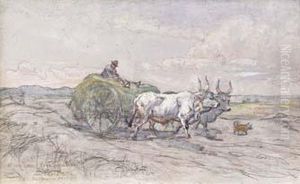Cesare Pascarella Paintings
Cesare Pascarella was an Italian dialect poet, writer, and painter, born on May 28, 1858, in Rome, Italy. His artistic career was marked by his multifaceted talents, honing his skills not only in poetry but also in visual arts. Pascarella's literary work is particularly noted for its use of Romanesco, the dialect of Rome, which he employed to great effect in his poetry, capturing the essence of the city's culture and the idiosyncrasies of its people.
Pascarella's most famous work is 'La scoperta dell'America' (The Discovery of America), published in 1893, which is a satirical poem that recounts Christopher Columbus's discovery of the New World from a humorously parochial Roman perspective. His poetry often addressed contemporary events and everyday life, imbuing them with wit, irony, and a keen social commentary that resonated with readers of his time.
Aside from his literary pursuits, Cesare Pascarella was also involved in the art world, though his paintings and drawings are less well-known than his writings. His artistic style was influenced by the verismo movement, an Italian realist movement that also permeated his literary works. Pascarella's paintings often featured scenes from daily life, landscapes, and portraits, displaying a keen eye for detail and a dedication to representing his subjects with authenticity.
Throughout his life, Pascarella was associated with several cultural circles and was recognized as a prominent figure in Roman literary and artistic society. He was a member of the Accademia degli Arcadi, a literary academy in Rome, and his works were celebrated for their vivid portrayal of Roman life and culture.
Cesare Pascarella passed away on March 8, 1940, in Rome. His legacy as a poet and artist remains, with his works continuing to be appreciated for their humor, critical insight, and their celebration of Roman dialect and culture. Pascarella's contributions to Italian literature and art have earned him a place among the notable cultural figures of his era, and his works are still studied and enjoyed by those interested in the linguistic and cultural history of Rome.

